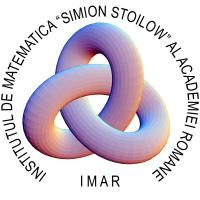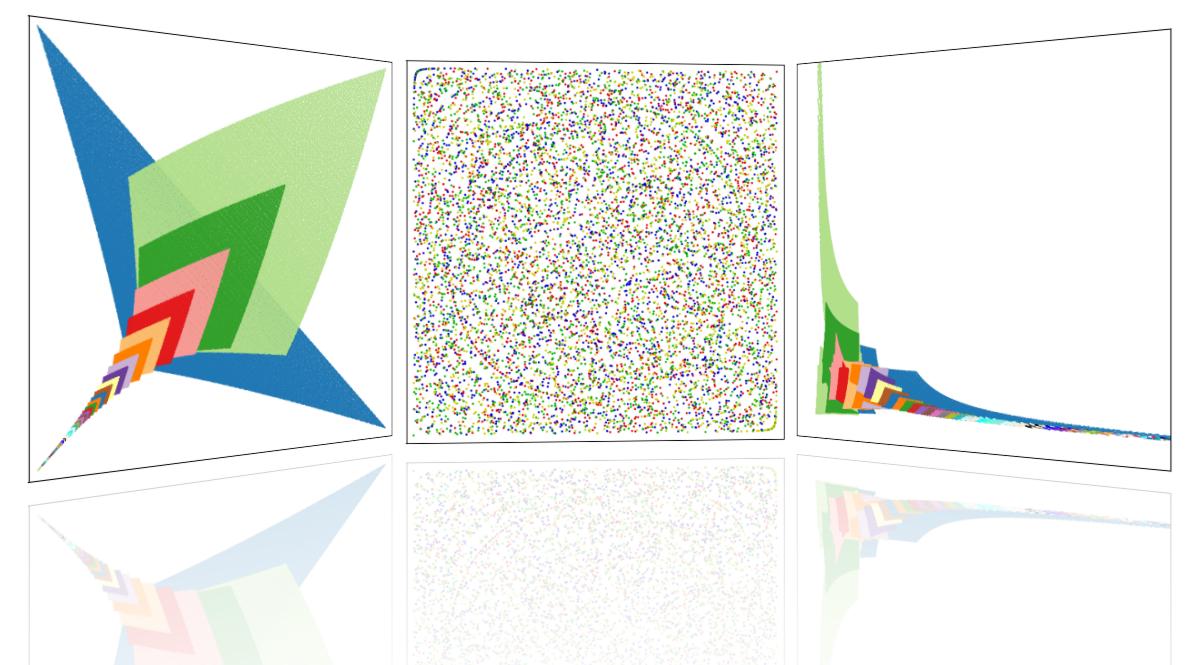
Ninth Bucharest Number Theory Days
June 1-3, 2021
In honor of Alexandru Zaharescu's 60th Birthday


 |
Ninth Bucharest Number Theory Days |
 |
 |
| Home | Schedule & Abstracts | Registration |
| Chicago time | June 1st | June 2nd | June 3rd | Bucharest time |
|---|---|---|---|---|
| 8:00-8:40 | Shparlinski | Kim | 16:00-16:40 | |
| 8:50-9:30 | Berndt | Xiong | Dixit | 16:50-17:30 |
| 9:40-10:20 | Murty | Ioviță | Matomäki | 17:40-18:20 |
| 10:30-11:10 | Buium | Diaconu | Marklof | 18:30-19:10 |
| 11:10-11:40 | Break | Break | Break | 19:10-19:40 |
| 11:40-12:20 | Sarnak | Ford | Kontorovich | 19:40-20:20 |
| 12:30-13:10 | Soundararajan | Granville | Athreya | 20:30-21:10 |
| 13:20-14:00 | Radziwill | Yee | Luca | 21:20-22:00 |
| 14:10-14:50 | Remarks/speeches | Popescu | Cobeli | 22:10-22:50 |
Jayadev Athreya, Counting Tripods
Motivated by some problems from theoretical physics, we describe a toy model problem of counting isometric immersions of certain graphs
in the flat torus and related lattice point counting problems. This is joint work with David Aulicino and Harry Richman.
There will be lots of pictures, and hopefully, some discussion of the motivations.
Bruce Berndt,
Balanced Derivatives, Identities, and Bounds for Trigonometric Sums and Bessel Series
Motivated by two identities published with Ramanujan's lost notebook and connected, respectively,
with the Gauss circle problem and the Dirichlet divisor problem, in a paper published in
J. Reine Angew. Math. in 2013, Zaharescu, Sun Kim, and the speaker derived representations
for certain sums of products of trigonometric functions as double series of Bessel functions.
With Martino Fassina, in a recently submitted paper, we returned to the ideas from our Crelle
paper. The aforementioned series are generalized by introducing the novel notion of balanced
derivatives, leading to further theorems. The regions of convergence in the unbalanced case
are different from those in the balanced case. If \(x\) denotes the number of products of
the trigonometric functions appearing in our sums, in addition to finding more efficient
proofs of the identities mentioned above, we establish theorems and conjectures for upper and
lower bounds for the trig sums as \(x\to\infty\).
Alexandru Buium, Arithmetic PDEs
Some of the classical ODEs (Riccati, Weierstrass, Painlevé, etc.)
have arithmetic analogues in which derivatives of functions are replaced by Fermat quotients of numbers.
These lead to Diophantine applications (related to the Manin-Mumford conjecture, Heegner points, etc.)
Recently, in joint work with L. Miller, arithmetic analogues of some classical PDEs were introduced.
An application to a new type of reciprocity law will be presented.
Cristian Cobeli, Fractions, leaveswings and ladders
We discuss the properties of a few sequences related to ratios of
positive integers and look at the
twists of their generated representations.

Adrian Diaconu,
Braids, scanning, and moments of L-functions
In this talk, I will discuss recent results, in joint work with Bergstr̈m,
Petersen, and Westerland, concerning the relationship between the conjectural
asymptotic formula for moments of quadratic Dirichlet L-series in the
function-field setting, and the stable homology of braid groups with
coefficients in symplectic representations.
Atul Dixit,
Superimposing theta structure on a generalized modular relation
By a modular relation for a certain function \(F\), we mean a relation governed by
the map \(z\to -1/z\) but not necessarily by \(z\to z+1\). Equivalently, the
relation can be written in the form \(F(\alpha)=F(\beta)\), where \(\alpha\beta=1\).
There are many generalized modular relations in the literature such as the theta
transformation \(F(w,\alpha)=F(iw, \beta)\) or the Ramanujan-Guinand formula
\(F(z, \alpha)=F(z, \beta)\) etc. The latter, equivalent to the functional equation of
the non-holomorphic Eisenstein series on \(\textup{SL}_{2}(\mathbb{Z})\), admits a
beautiful generalization of the form \(F(z, w,\alpha)=F(z, iw, \beta)\) obtained
by Kesarwani, Moll and the speaker, that is, one can superimpose theta structure
on it.
In 2011, the speaker obtained a generalized modular relation involving infinite
series of the Hurwitz zeta function \(\zeta(z, a)\). It generalizes a result of
Ramanujan from the Lost Notebook. Can one superimpose theta structure on the
generalized modular relation? While answering this question affirmatively, we
were led to a surprising new generalization of \(\zeta(z, a)\). We show that this
new zeta function, \(\zeta_w(z, a)\), satisfies a beautiful theory. In particular,
it is shown that \(\zeta_w(z, a)\) can be analytically continued to Re\((z)>-1\) and
has a simple pole at \(z=1\). We also prove a two-variable generalization of
Ramanujan's formula which involves infinite series of \(\zeta_w(z, a)\) and which
is of the form \(F(z, w,\alpha)=F(z, iw, \beta)\). This is joint work with Rahul
Kumar.
Kevin Ford,
The behavior of Euler's function at consecutive arguments,
and gaps between Euler function values
There is an old conjecture that \(\phi(x)=\phi(x+1)\) infinitely often, still unsolved.
Recently, we made progress on the conjecture showing that \(\phi(x)=\phi(x+k)\) infinitely
often for many values of \(k\). The proof utilizes recent progress on small gaps between primes.
We also look at gaps between values taken by Euler's function, showing in particular
that gaps of size at most 154 occur infinitely often; by contrast, it is known that
gaps between primes are at most 246 occur infinitely often. Finally, we discuss analogs of
these problems for the sum of divisors function.
Andrew Granville,
(Effective) size and structure of sumsets
Let \(A\) be a subset of \(\mathbb{Z}^d\) which additively generates \(\mathbb{Z}^d\).
Let \(NA=\{ a_1+\dots +a_N: a_i\in A\}\). Khovanskill (1992) proved that there
exists a polynomial \(P_A(X) \in \mathbb{Q}[X]\) of degree \(d\) such that
\(\vert NA\vert = P_A(N)\) if \(N\) is sufficiently large. Shakan and I (2020)
proved that \(NA\) has a certain structure once \(N\) is sufficiently large.
Both results had ineffective proofs. We now give the first bounds for what
``sufficiently large'' means in each case, using linear algebra techniques.
This is joint work with George Shakan and Aled Walker.
Adrian Ioviță,
\(p\)-Adic uniformization of a class of abelian varieties with good reduction
I will report on a joint project with J. Morrow and A. Zaharescu. Investigating
the \(p\)-adic integration map constructed by J.-M. Fontaine during the 90's, which is
the main tool for proving the Hodge-Tate decomposition of the Tate-module of an abelian
variety over a \(p\)-adic field, we realized that the group of \(p\)-adic points of the
above-named abelian variety, satisfying certain hypothesis, has a type
of \(p\)-adic uniformization which was not remarked before. I will discuss our findings
and conjectures in this setup.
Sun Kim,
The distribution of spacings between the fractional parts of \(n^d\alpha\)
We study the distribution of spacings between the fractional parts of \(n^d\alpha.\)
For \(\alpha\) of high enough Diophantine type, we prove a necessary and
sufficient condition for \(n^d\alpha\mod 1, 1\leq n\leq N,\) to be Poissonian
as \(N\to \infty\) along a suitable subsequence.
This is joint work with Martino Fassina and Alexandru Zaharecu.
Alex Kontorovich,
Length Saturation for Zariski Dense Groups
We study the effect on the set of lengths of closed geodesics under taking
covers of a given hyperbolic manifold M. When M is sub-arithmetic (that is, when
its fundamental group is a subgroup of an arithmetic group), its trace set is
contained in the ring of integers of a number field; to what extent is there a
"local-global principle" for such trace values under taking covers? For example,
there is no reason for the systole to remain, so some small geodesic lengths may
be lost in the cover. We report on progress (with Xin Zhang) in understanding
"length saturation" for Zariski dense, punctured, subgroups of the modular
group.
Florian Luca,
Some results on the Ramanujan \(\tau\)-function
Let \(\tau(n)\) be the Ramanujan \(\tau\)-function of \(n\). In 2009, Alkan, Ford
and Zaharescu proved that for every real number \(\beta\) there is a constant
\(C_{\beta}\) such that the Diophantine inequality
$$
\left|\frac{\tau(n)}{n^{11/2}}-\beta\right|<\frac{C_{\beta}}{\log n}
$$
has infinitely many integer solutions \(n\ge 2\). In this talk, I will survey some
of my recent results concerning distributional properties of the Ramanujan
\(\tau\)-function which were inspired by the above result. I will also mention
some results on prime factors of \(\tau(n)\) and its iterates. For example,
assuming the Lehmer conjecture that \(\tau(n)\ne 0\) for all \(n\), if \(n\) is even
and \(k\ge 1\), then \(\tau^{(k)}(n)\) is divisible by a prime \(p\ge 3^{k-1}+1\).
Given a fixed finite set of odd primes \(S=\{p_1,\ldots,p_\ell\}\) we give a bound
on the number of solutions \(n\) to the equation \(\tau(n)=\pm p_1^{a_1}\cdots
p_\ell^{a_\ell}\) for integers \(a_1,\ldots,a_\ell\) and in case \(S:=\{3,5,7\}\), we
show that there is no such \(n>1\).
Jens Marklof,
Pair correlation of the roots of quadratic congruences
In 1963 Christopher Hooley showed that the roots of a quadratic congruence mod m,
appropriately normalized and averaged, are uniformly distributed mod 1.
In this lecture, which is based joint work with Matthew Welsh (Bristol),
we will study pseudo-randomness properties of the roots on finer scales
and prove for instance that the pair correlation density converges to an intriguing limit.
A key step in our approach is to translate the problem to convergence of certain
geodesic random line processes in the hyperbolic plane.
Kaisa Matomäki,
Exceptional characters and primes in almost all very short intervals
By probabilistic models, one expects that short intervals of
the type \([x, x+h\log X]\)
contain primes for almost all \(x \in [X, 2X]\) as soon as \(h \to \infty\)
with \(X \to \infty\), but this is far from being established. In the talk
I will describe on-going work with Jori Merikoski where we prove this
for many scales \(X\) under the unlikely assumption that there are
exceptional characters (i.e. characters for which \(L(1, \chi) \log q\) is
small).
Ram Murty,
The vanishing of L-series and the Okada space
If \(f\) is a complex-valued arithmetical function with period \(N\), we associate
the \(L\)-series
\[L(s,f)=\sum_{n=1}^\infty \frac{f(n)}{n^s}
\]
It is easy to see that this series converges for \(\Re(s) > 1\) and admits an
analytic continuation to the entire complex plane except at \(s = 1\) where it has a
simple pole with residue
\[\frac{1}{N} \sum_{a=1}^N f(a)
\]
Thus, \(L(1, f )\) is finite if and only if the residue is zero, which we shall assume.
The Okada space consists of all such functions \(f\) for which \(L(1, f ) = 0\). We
construct an explicit basis for this vector space. As a consequence, we are able
to derive results about \(\mathbb{Q}\)-linear relations among special values of the digamma
function at rational arguments. This is joint work with Siddhi Pathak.
Cristian Popescu,
An Equivariant Tamagawa Number Formula for Drinfeld Modules and Beyond
I will present a vast generalization of Taelman's 2012
celebrated class-number formula for Drinfeld modules to the setting of
(rigid analytic) L-functions of Drinfeld modular motives with Galois
equivariant coefficients. I will discuss applications (e.g. a proof of the
Drinfeld module analogue of the Brumer-Stark conjecture) and potential
extensions of this formula to the category of t-modules and t-motives.
This lecture is based on the paper:
https://arxiv.org/abs/2004.05144,
joint with J. Ferrara, N. Green and Z. Higgins.
Maksym Radziwill,
Multiplicative functions in short intervals II
I will discuss joint work with Kaisa Matomaki on
multiplicative functions in short intervals. We revisit our earlier
work with applications in mind, notably towards gaps between
norm forms of general number fields, extending earlier results
of Hooley-Plaksin for quadratic number fields.
Peter Sarnak,
Convergence to Plancherel measure of Hecke eigenvalues
We give rates, uniform in the degrees of the
test polynomials, of convergence to the Plancherel measure of Hecke eigenvalues.
These are applied to resolve questions about sharp cutoff for random walks in
Ramanujan graphs, as well as to a question of Serre concerning the factorization
of the Jacobian of the modular curves \(X_0(N)\). Joint work with Nina Zubirilina.
Igor Shparlinski, Weyl Sums: Large, Small and Typical
While Vinogradov's Mean Value Theorem, in the form given by J. Bourgain, C. Demeter and L. Guth (2016) and T. Wooley (2016-2019), gives an essentially optimal result on the power moments of the Weyl sums
\[
S(u;N) =\sum_{1\le n \le N} \exp(2 \pi i (u_1n+\ldots+u_dn^d))
\]
where \(u = (u_1,\ldots,u_d) \in [0,1)^d,\) very little is known about the distribution, or even existence, of \(u \in [0,1)^d\),
for which these sums are very large, or small, or close to their average value \(N^{1/2}\). In this talk, we describe recent progress towards these and some related questions.
In particular, we give new results on the spectrum of possible sizes of Weyl sums. We also present some new bounds on `slices' of \(S(u;N)\),
that is, bounds which hold for almost all \((u_i)_{i\in I}\) and all \((u_j)_{j\in J}\), where \(I \cup J\) is a partition of \({1,\ldots,,d}\),
which improve a previous result of T. Wooley (2015).
Finally, we discuss lower bounds on slices of Weyl sums, generalising that of J. Brandes, S. T. Parsell, C. Poulias, G. Shakan and R. C. Vaughan (2020).
Joint work with Julia Brandes, Changhao Chen, Bryce Kerr, James Maynard.
Kannan Soundararajan,
Equidistribution from the Chinese Remainder Theorem
Suppose for each prime \(p\) we are given a set \(A_p\) (possibly empty) of residue
classes mod \(p\). Use these and the Chinese Remainder Theorem to form a set \(A_q\) of
residue classes mod \(q\), for any integer \(q\). Under very mild hypotheses, we show
that for a typical integer \(q\), the residue classes in \(A_q\) will become
equidistributed. The prototypical example (which this generalizes) is Hooley's
theorem that the roots of a polynomial congruence mod \(n\) are equidistributed on
average over \(n\). I will also discuss generalizations of such results to higher
dimensions, and when restricted to integers with a given number of prime
factors. Finally I will discuss bounds on averages of exponential sums of
polynomial phases, extending earlier work of Hooley, and Fouvry and Michel.
(Joint work with Emmanuel Kowalski.)
Maosheng Xiong,
Random matrices formed from linear codes over finite fields
It is known that the empirical spectral distribution of random matrices
obtained from linear codes of increasing length converges to the
Marchenko-Pastur law, if the Hamming distance of the dual codes is at least 5.
In this talk we describe the convergence rate and some other results related to
the topic.
Ae Ja Yee,
Combinatorics of Truncated Partition Theorems
In 2012, Andrews and Merca derived a truncated version of Euler's pentagonal
number theorem, which yields the following partition inequalities:
For \(k\ge 1\) and \(n \ge 1\),
\[
(-1)^{k-1} \sum_{j=0}^{k-1} (-1)^j \left(p\bigg(n-\frac{j(3j+1)}{2}\bigg) - p\left(n-\frac{(j+1)(3j+2)}{2}\right) \right) \geq 0,
\]
where \(p(N)\) denotes the partition function.
The work of Andrews and Merca has opened up a new study on truncated theta
series inspiring several mathematicians to work on truncated theta series. In
this study, analytic and combinatorial methods have been equally instrumental,
but it seems hard to identify any common thread that runs through all existing
combinatorial proofs. Recently, Ernest Xia and Xiang Zhao found several new
identities on truncated series, which motivated me to study the whole phenomena
from a combinatorial point of view. In this talk, I will present some ideas and
progress made.